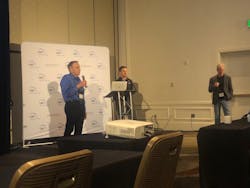Digital transformation has been a theme at the ARC Industry Forum for a few years, and it is a direct reflection of what is happening across the entire manufacturing industry. Every company is trying to adopt new technology in the form of sensors, analytics, edge devices, cloud infrastructure, and more—all with the goal of leveraging automation and the Industrial Internet of Things (IIoT) to create a more productive and flexible organization.
But there’s also a common problem: Where to start and how to scale?
At the ARC Forum this year, technology suppliers showed up with new offerings that have been built to solve these problems associated with digital transformation, specifically as it pertains to the dreaded “pilot purgatory.”
One of the companies at the forefront of the effort is Inductive Automation. “We are turning the hard, frustrating, and ridiculously expensive [project] into easy, affordable, and fun,” said Don Pearson, Inductive Automation’s chief strategy officer. Did he say, “fun?” Well, developers who have been using the company’s Ignition platform over the last 10 years seem to be pretty happy about the new industrial applications they are creating from SCADA to MES to IIoT.
At the ARC Forum, Inductive announced enhancements to its Ignition Edge product—which embeds data collection capabilities into field devices—that address obstacles associated with digital transformation: collecting data at the edge, turning data into action, project development, and the expense of implementation. The new Ignition Edge offerings include Ignition Edge Panel which creates local HMIs for field devices; Ignition Edge Compute brings intelligence to the edge; Ignition Edge Sync Services synchronizes data at the edge of the network; Ignition Edge Enterprise Administration Module (EAM) manages multiple Ignition installations; and Ignition Edge IIoT can publish and access field device data from the edge.
Ignition Edge includes the Message Queuing Telemetry Transport (MQTT) agent in it, which is a lightweight publish/subscribe network protocol from Cirrus Link Solutions that transports messages between devices that may be constrained by low-bandwidth, high-latency networks—otherwise known as a machine-to-machine (M2M) IIoT connectivity protocol.
Since the introduction of the MQTT module to the Ignition platform four years ago, the product line has evolved to cater to requests from customers. “As edge products expand, manufacturers have more need for distributed systems that place devices closer to the sources of data,” said Travis Cox, Inductive’s co-director of sales engineering. “You can visualize and trend [data] locally and have more powerful calculations like OEE right there.”
Manufacturers also want to bring content to the cloud to do big data analytics, and the Ignition tools with Cirrus Link MQTT offer a workaround to the existing inflexible infrastructure.
“Everyone sees the vision of getting data to the cloud to do analytics, but where are they getting the data? They say it’s operational data, but we know that the current infrastructure is not conducive to digital transformation,” said Arlen Nipper, president and CTO of Cirrus Link. “Before starting a journey toward digital transformation you need to look at the OT infrastructure. Doing one-off [projects] leads to pilot purgatory, and you end up with coding on the OS that won’t scale or move to the next plant. It’s all about tools on platforms vs. coding on operating systems. We’ve developed a line of modules that run on Ignition that take any tag in any Ignition gateway or edge device and publish it to any cloud provider.”
In addition to the new tools, Inductive Automation also announced new programs that will make it easier to access industrial hardware. The Ignition Onboard program includes a range of device manufacturers that have pre-installed, configured, and licensed Ignition and Ignition Edge into their products— including Advantech, Moxa, OnLogic, Opto 22, and ORing.
Ignition Exchange is a new, online space where developers can get free Ignition resources provided by the Ignition community. Lastly, a new Ignition Perspective module includes more features for building mobile industrial applications in HTML5 for monitoring and control of processes directly from a mobile phone.
“Many organizations have hit roadblocks in their digital transformation efforts,” Pearson said. “These new and improved solutions are helping people move past those. When you give people unlimited licensing, more power at the edge, software pre-installed on devices, better mobility, and an entire community of development resources, they can move forward in ways they never could before.”
For more coverage of new from the ARC Forum, see:
Seeking an End to Pilot Purgatory
Work on IoT Device Communication Standardization Begins
Note: PMMI Media Group editors have purchased carbon credits through cooleffect.org to ensure flights we take to cover the ARC Industry Forum are carbon neutral
Leaders relevant to this article:

